SBU chief reveals details of two operations to blow up Crimea Bridge ... The cracked bridge. SBU Chief Vasyl Malyuk spoke in detail for the first time about how his team blew up the Crimean bridge twice — NV exclusive
SBU chief reveals details of two operations to blow up Crimea Bridge
That’s according to the SBU chief, Vasyl Maliuk, who spoke in an interview with NV magazine, the SBU told Ukrinform.
"It was an indescribable feeling. When the explosion happened, we screamed so loudly as the tension inside was huge," said Maliuk, who personally planned and supervised the special operation.
According to the head of the security agency, in order to inconspicuously transport 21 tons of hexane to the bridge, the SBU operatives wrapped the explosives with packaging film, which the shipping papers said the truck was officially transporting.
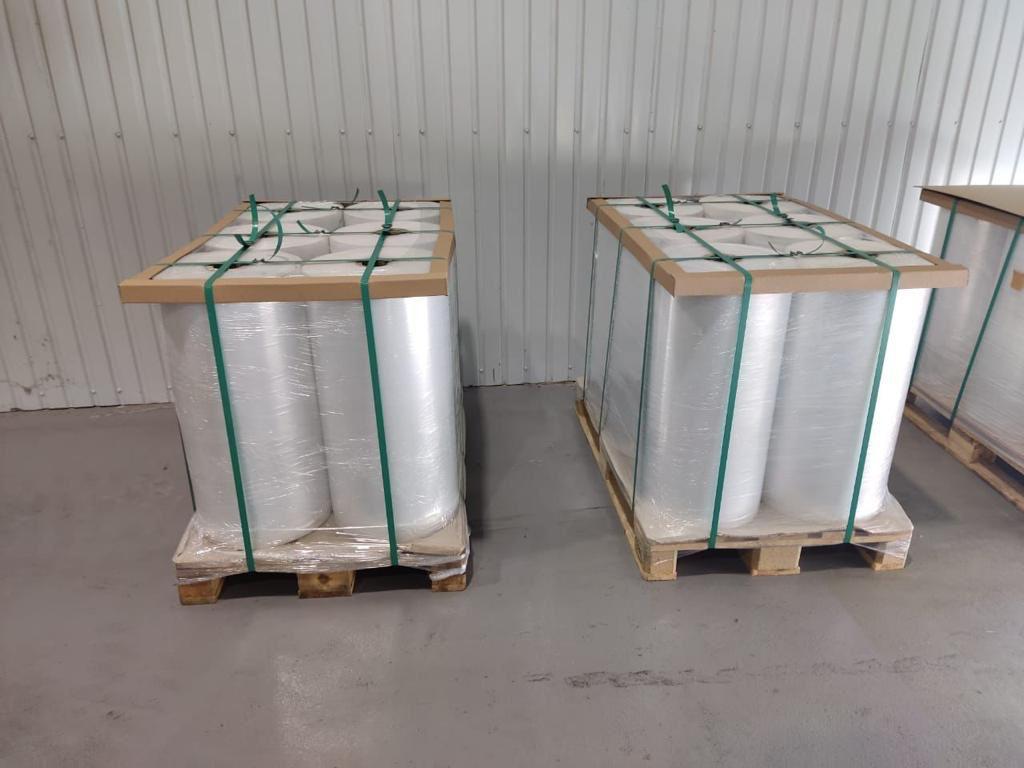 Read also: Maliuk: Drones that damaged Crimean Bridge in July are SBU’s invention
Read also: Maliuk: Drones that damaged Crimean Bridge in July are SBU’s inventionThe Security Service released unique photos showing the preparations for the operation.
In addition, according to Maliuk, the SBU managed to bypass special jammers on the Crimea Bridge that alter GPS coordinates.
"We went through the seven circles of hell, we used so many Russians who remained oblivious!" says the head of the SBU.
He noted that an unnamed operative with the call sign "Hunter" played a major role in organizing the second attack on the Crimea Bridge in July 2023. He put a lot of effort into creating naval drones, which incurred damage to one of the symbols of the Putin regime. The amount of explosives carried by the drones was increased to 850 kg worth of hexane. The drone control system was modernized to create a qualitatively new model of the Avenger. Remotely controlled kamikaze watercraft are made of a unique material that is invisible to enemy radars. Their design provided for three types of control and self-destruction if necessary.
The head of the SBU emphasized that the Crimea Bridge is a legitimate target for Ukraine, and that the Geneva Conventions, which regulate the rules of warfare, contain no ban on attacking such objects.
 Read also: Kerch Strait Bridge reflects current situation in Russia - Ukraine’s Navy Command
Read also: Kerch Strait Bridge reflects current situation in Russia - Ukraine’s Navy CommandAs reported, there were two explosions on the Crimea Bridge. The first was on October 8, 2022, when the railway track of the bridge was damaged as a result of the blast and several spans of its motorway section were destroyed. The second explosion occurred on July 17.
Photo: SBU

The SBU blew up the Crimean Bridge twice (the photo shows the consequences of the first attempt in October 2022), explaining that this object was built illegally and is being used by the Russian Federation for military purposes (Photo: AFP via EastNews)
" Only the chosen ones saw these shots," says SBU head Vasyl Malyuk, showing a video dated July 17, 2023, on his phone screen.
On it, a group of special service employees views images from a marine drone camera on a computer monitor. The device diligently maneuvers on the waves, sliding in the direction of a massive structure, which can be recognized as one of the sections of the so-called Crimean Bridge, built by the Russians across the Kerch Strait after the occupation of the peninsula. In the background, the voice of the Kid himself is heard, addressing the drone operator: "Quiet, quiet." Waves crash over the hull of the unmanned ship as it inexorably approaches the abutment of the bridge. A moment - and the image from the camera fades, and the people present around the monitor jump up with joy.
Hiding the phone, Malyuk explains that the video recorded the second attack on the bridge, as a result of which a part of the span of its car part collapsed. "It was an indescribable feeling. Many months of development and success - it is difficult to describe this in words," says the head of the SBU about his emotions.
The operation to re-blow up the Crimean bridge in the SBU, on the initiative of the personnel, was named symbolically - Sea Kid. By the way, the new generation of surface drones used by the SBU has the same name.
Eight months before this special operation, Malyuk's team first targeted the bridge, which is a key segment of Russian military supplies to Crimea and the occupied south of Ukraine.
Impact #1 occurred on the overcast morning of October 8, 2022. At that moment, a large stream of cars was crossing the bridge. In this traffic, at 5:40 a.m., the camera of the Russian video surveillance system recorded a loaded truck moving at high speed towards Crimea. In an instant, the long gauge exploded, damaging two spans and igniting a railway train with tanks filled with fuel, which was moving in parallel. According to the Russian side, five people died from the impact, including the truck driver, and traffic on the bridge was completely stopped.
Not only the occupiers were watching that explosion - there was another camera, the video of which was watched in real time by Malyuk in his office in Kyiv. The head of the SBU does not reveal where it was stored, but assures that he watched the explosion in all its details.
The first operation on the Crimean bridge angered the Russian dictator Vladimir Putin, for whom this crossing became a symbol of his own success. After the detonation, which occurred the day after the 70th anniversary of the Kremlin's master of the day, the Russians launched a powerful missile attack on Kyiv and began methodically shelling Ukraine's energy infrastructure. In addition, the Russian Federation created a special commission to investigate the circumstances of the explosion, which included representatives of the Ministry of Emergency Situations, the Ministry of Transport, the FSB, the Ministry of Internal Affairs and the Russian Guard. Subsequently, the Russian court sent eight suspects to SIZO, but none of them have been proven guilty so far. According to the SBU's assessment, the Moscow " investigation" demonstrated an extreme degree of unprofessionalism, because it announced a wanted list for the head of the State Security Service, Kyril Budanov, who had nothing to do with the operation.
The repeated attack on the bridge made a depressing impression on the Kremlin, strengthening Moscow in the understanding that Ukraine is capable of destroying this illegally built large-scale structure. Although the Russian side has repeatedly declared that the bridge is invulnerable to any type of weapon and has created a special security system around it.
" The Kerch bridge has become a fictional grail for the Kremlin. Therefore, its destruction not only disrupted logistics, but also showed that Putin's regime is as fragile and unstable as the structure of the bridge, - believes Oleksandr Kovalenko, a military-political expert of the Infoprotiv group. "This special operation had military and political goals, and they were all incredibly successful."
The first explosion
" I personally and two of my trusted employees were engaged in the development and implementation of the special operation with the bridge," explains Vasyl Malyuk.
According to him, the SBU had been harboring the idea of blowing up the Crimean bridge since the spring of 2022. Various options were considered. They were thinking of transporting the explosives in freight cars. But the Russians forbade the transportation of any cargo, except for the military, over the railway part of the bridge. In the end, they settled on the option with a truck loaded with barrels of oil, in which explosives would be hidden.
But doubts about the effectiveness remained. "It was important that the camouflaged explosives could travel from point A to point B. At the same time, it was necessary to cross the Kerch bridge," Malyuk explains. The option with barrels did not guarantee such "inconspicuousness".
And then the head of the SBU invented a variant with explosives carefully wrapped in cellophane film. Such cargo - large rolls - looked completely civilian and should not have aroused suspicion.
The SBU calculated the thickness of the film layer, sufficient to hide from the customs scanners the metal cylinders-cores pumped with a mixture of hexane.
" Rolls" hit an entire container - their total weight in TNT equivalent corresponded to 21 tons, or 42 Russian " hypersonic" Kinzhal missiles.
The passage of cargo from Ukraine to the place of the explosion on the bridge was very difficult. But Vasyl Malyuk does not disclose the details of this risky route, referring to the fact that it is still necessary to comply with the requirements of the conspiracy.
However, the head of the SBU emphasizes that it was a thorny path. And the Ukrainian special service carried the cargo through it without the involvement of foreign partners. The capabilities of the SBU were used exclusively. That once again emphasizes the high level of the special operation, Malyuk notes.
The SBU had to take into account one more important point: there are special EWs at the posts near the Crimean bridge, whose task is to knock down the GPS coordinates of explosive devices set to a certain point. The team assembled by Malyuk created a technically complex system, thanks to which, in the early morning of October 8, 2022, the cargo of "film" still flew into the air approximately in the middle of the bridge.
" We went through the seven circles of hell, used so many people in the dark! The Russians " closed" 22 people - imprisoned them. All of them are charged with complicity in a terrorist act. Although in fact they were doing their usual everyday business. They were ordinary Russian smugglers," says Malyuk with a smile.
The Kremlin did not understand this issue for a long time . Already six days after the attack, five citizens of the Russian Federation, suspected of complicity, ended up in pre-trial detention centers. Later, their number increased.
Russian opposition journalist Olena Romanova, who lives in Germany and works for Novaya Gazeta. Europe wrote about one of them, Oleg Antipov, a logistician from St. Petersburg. One of the transport agreements for the transportation of 21 tons of "polyethylene film" went through him.
Antipov himself came to the FSB after the bridge explosion, told what he knew - he was released, and then detained and sent to a detention center. The St. Petersburg logistician is still warming up in the pre-trial detention center, becoming a living example of the common practice among Russian special services — to look for the easiest " investigation" option in difficult cases . "Security forces in the Russian Federation need to show their effectiveness. That's why they grab the first and best suspect and hang all the sins of the world on him," says Romanova.
Second explosion
After the " first test of the pen", the SBU immediately began to develop a new attack on the bridge.
A major role in the implementation of this idea was played by the head of one of the military counter-intelligence departments, a pseudo officer called Hunter, who contributed to the creation of naval drones.
Ukrainian special services created explosive-filled remotely controlled kamikaze watercraft, made of a unique material invisible to enemy radars, the design of which provided for three types of control and self-destruction in case of need.
For the first time in the circumstances of a real battle, engineers and specialists of the SBU tested floating drones on ships of the Russian Black Sea Fleet, when the missile frigates Admiral Makarov and Admiral Essen attacked in Sevastopol Bay last fall. The latter, after this special operation, stood in the dock for a long time for repairs.
Realizing that drones are not capable of sinking large ships, the amount of explosives on them was increased to 850 kg of hexane. They also modernized the drone control system, receiving a qualitatively new model of the surface " Avenger".
Malyuk enlisted the cooperation of the commander of the Navy Oleksiy Neizhpapa, who provided significant assistance in the implementation of the entire project. The combined team of the fleet and special services began to prepare a naval operation to blow up the Crimean bridge.
The drones continued to be improved, even installing two high-range Shmel-M jet flamethrowers on the hull. There were other know-how, the details of which have not yet been disclosed by the SBU. Modified drones were ready to perform extremely difficult tasks.
In mid-July, the SBU and the Navy finally released the drones into the open sea, directing them to the target. "For two nights we did not sleep - literally every minute we watched the drones. We were on such a drive that we had to calm down the guys a little so that they wouldn't chase the drones," recalls Malyuk.
In the end, the drones hit the support of the bridge, throwing from it, judging by the photos released later, the entire span of its car part.
" When the explosion happened, we screamed very loudly because the tension inside was huge," Malyuk admits. - I'll be honest: I prayed that everything would work out. And when the drone exploded, we also "exploded" with joy.
Legitimate purpose
The head of the SBU, describing to NV the details of the attacks on the Crimean bridge, emphasized several times: these operations were prepared exclusively by the forces of Ukraine, and no foreign special services were involved in them.
Similarly, Malyuk clarified that the Crimean bridge is a legitimate goal for Ukraine. For example, the Geneva Conventions, which regulate certain rules of warfare, do not contain a ban on attacking such objects. And the Liber Code — the Instruction for the management of the active US army — defined as a legitimate goal " obstructing the ways and channels of movement, movement or communication."
In his turn, Valery Kondratyuk, the former head of the GUR and ex-explorer of the Foreign Intelligence Service, commenting on the actions of his colleagues from the SBU, assures that the operations with the bridge were carried out in such a way as to cause maximum damage to the Kremlin and maintain good relations with Western partners.
" It is a very delicate job for the special services to be effective and succeed in operations, balancing between the fears of foreigners before a nuclear war," Kondratiuk believes. "This formula encapsulates the hard work and titanic self-sacrifice of Ukrainians."
This article was first published in NV Magazine #3 for August 2023.

The first strike on the Crimean Bridge on the morning of October 8, 2022, just a day following Vladimir Putin’s 70th birthday celebration, featured a truck laden with explosives, expertly wrapped in plastic film. Ukraine launched a second assault on the bridge during the night of July 17, 2023, utilizing maritime drones, subsequently coined the “Marine Baby” operation.
The NV magazine has pieced together these historical events by engaging in conversations with Vasyl Maliuk, the head of Ukraine’s Security Service (SBU), who recently shared insights on the second strike with CNN.
Maliuk stressed that these strategic endeavors were exclusively the result of Ukraine’s meticulous planning, emphasizing the absence of involvement from foreign intelligence agencies. “I, alongside two trusted colleagues, were at the helm of the planning and execution of the bridge operation,” Maliuk recounted to NV, referring to the initial attack.
A deep dive into Ukraine’s expertly orchestrated first strike
According to Maliuk, the blueprint for sabotaging the Crimean Bridge was conceptualized as early as the spring of 2022. Myriad strategies were considered, encompassing transporting explosives within cargo wagons (yet such vehicles were exclusively for military use by the Russian forces) or concealing them within barrels of oil (which didn’t guarantee subtlety). Ultimately, Maliuk devised a stratagem involving explosives enshrouded within cellophane, masquerading as large rolls to evade suspicion.
The SBU calculated the thickness of the cellophane layer required to outfox customs scanners inspecting metal cylinders laden with a concoction of hexogen. These seemingly innocuous “rolls” efficiently filled an entire container, collectively equating to 21 tons or 42 Russian “hypersonic” Kinzhal missiles in TNT equivalence.
The logistical journey of transporting the payload from Ukraine to the bridge was rife with challenges. Maliuk refrains from divulging specifics of this perilous route, reiterating that the SBU exclusively orchestrated these feats, without external assistance.
Another critical consideration for the SBU was the existence of countermeasure equipment situated near the Crimean Bridge, designed to thwart GPS coordinates emanating from explosive devices targeted at specific locations. Maliuk’s team engineered a complex system to thwart these countermeasures, resulting in the successful flight of the cargo during the early hours of October 8, 2022, approximately halfway across the bridge.
From his office, Maliuk intently monitored the explosion in real-time through a surveillance camera, although the precise location of the camera remains undisclosed.
Maliuk recounted, “We traversed seven circles of hell and employed numerous individuals. The Russians apprehended 22 people, accusing them of complicity in a terrorist act. However, in reality, they were nothing more than ordinary Russian smugglers.”
Ukraine’s continuation of strikes on the Crimean Bridge
Following the initial triumph, the SBU promptly shifted focus to devising a subsequent attack on the bridge. A pivotal role in this endeavor was played by the head of a military counterintelligence department – an officer operating under the codename Hunter – who contributed significantly to the creation of naval drones.
Ukrainian intelligence operatives engineered remote-controlled kamikaze watercraft infused with explosives. These innovative vessels, constructed from a radar-eluding material, featured three control mechanisms and self-destruct functionality when deemed necessary.
In real combat conditions, these maritime drones made their debut by assaulting Russian Black Sea Fleet vessels, namely the Admiral Makarov and Admiral Essen frigates, situated in the Sevastopol bay during the previous fall. Post-operation, Admiral Essen underwent extensive repairs.
Recognizing the drones’ limitations in terms of incapacitating substantial vessels, the SBU augmented the explosives’ payload to 850 kg of hexogen. The control systems underwent upgrades, yielding an entirely new maritime “hunter.”
Collaborating with Navy Commander Oleksiy Neizhpapa, Maliuk orchestrated a synergistic partnership between the Navy and intelligence agencies to devise a maritime operation aimed at undermining the Crimean Bridge.
The drones underwent continuous enhancements, even boasting two long-range Shmel-M rocket launchers on their hulls. Numerous other innovations were incorporated, although the SBU has elected to withhold the finer intricacies.
In mid-July, the SBU and the Navy triumphantly launched the drones into open waters, steering them toward the designated target. Precision strikes by these drones impacted a bridge support, causing a section of the roadway to collapse, as evidenced by subsequently disseminated photographs.
In Maliuk’s words, “For two nights, sleep eluded us – we remained vigilant over the drones every passing minute. Our enthusiasm was so pronounced that we had to pacify our team members to prevent them from over-piloting the drones.
Upon the explosion, jubilation reverberated within the team – our collective tension had reached a zenith. Truthfully, I offered prayers for the operation’s success. And as the drone detonated, so did our exuberance.”
Home » Politics » International » Ukrainian security service says it carried out attack on Crimean bridge last Oct
Kiev, July 27 (SocialNews.XYZ) For the first time, the Security Service of Ukraine (SBU) has acknowledged its involvement in the October 22 attack on the Kerch Bridge that connects the occupied Crimean Peninsula to the Russian mainland.
“SBU officers have been destroying the enemy in the hottest spots and doing everything to liberate our land as soon as possible. The destruction of the Crimean bridge is one of our achievements," CNN quoted the Security Service's chief Vasyl Malyuk as saying at a ceremony here on Wednesday.
The SBU head's remark comes after Deputy Defence Minister Hanna Maliar became the first Ukrainian official earlier this month to hinted at the country's forces blowing up the bridge.
In a social media post, she had listed 12 Ukrainian achievements since Russia launched its full-scale invasion on February 24, 2022, and said that "273 days ago, (we) launched the first strike on the Crimean bridge to disrupt Russian logistics".
The Ukrainian government, however has not officially claimed the attack.
The Kerch bridge is a vital artery for supplying Russia’s ongoing war on Ukraine, allowing people and goods to flow into the Ukrainian territories that Moscow has occupied in the south and east of the country.
Ukrainian officials celebrated the October 2022 blast at the time but did not make a clear claim of responsibility.
It took place a day after Russian President Vladimir Putin turned 70, and Ukraine’s Secretary of the National Security and Defence Council Oleksiy Danilov published a video of the bridge in flames alongside a video of Marilyn Monroe singing, “Happy Birthday, Mister President”.
The Ukrainian Navy had also posted on Facebook, saying, “Air defence of the Russian Federation, are you sleeping?” alongside a video showing a section of the bridge’s road that had been completely destroyed.
On July 17, the bridge was again hit by two strikes, which a Ukrainian security official told CNN that Kiev was responsible for.
Source: IANS
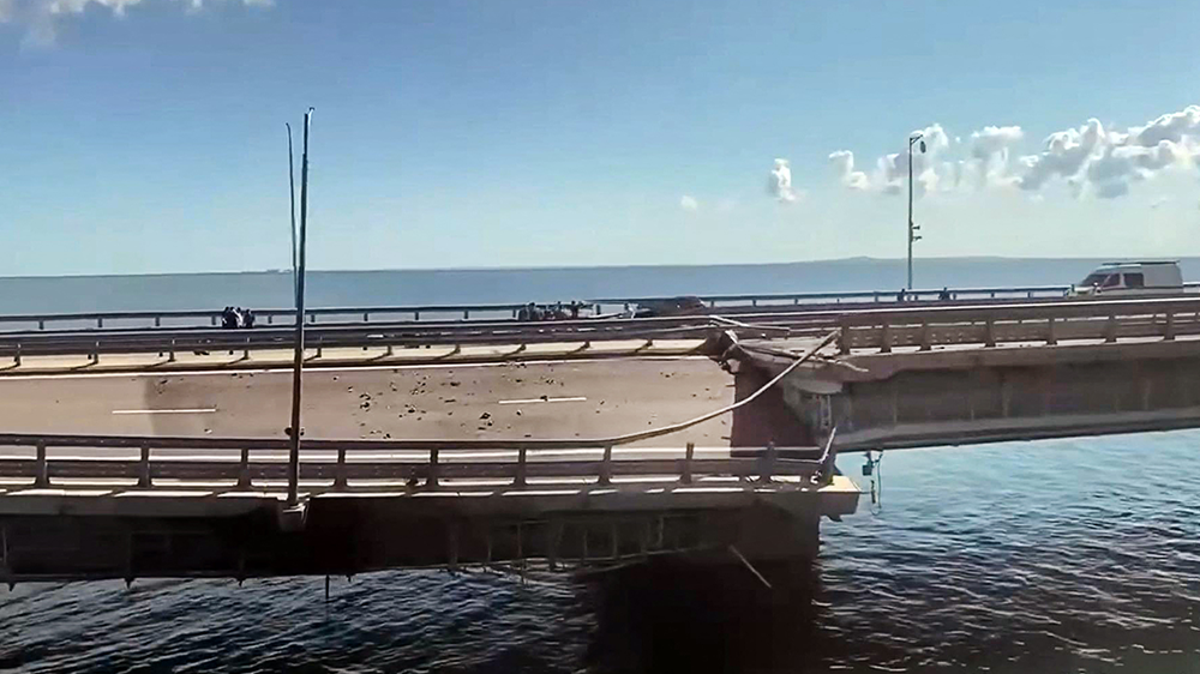
Ukraine’s security services have claimed responsibility for an attack on the vital bridge connecting Crimea to Russia last month.
The country’s intelligence bureau, the Security Service of Ukraine (SBU), said it used remotely controlled sea drones carrying 850kg of explosives to target the Crimean Bridge, a critical supply link built by Vladimir Putin in 2018.
The drone strike on 17 July damaged the bridge and killed two civilians, according to Russian officials.
Ukraine does not usually claim responsibility for such attacks, but spy chief Vasyl Maliuk confirmed the security services’ involvement in an interview with CNN and warned the Russian president that more similar strikes will follow.
Mr Maliuk said the drones called 2Sea Baby” were developed internally by the SBU, which has now released footage to CNN showing the pilot’s screen moments before the attack alongside CCTV of the immediate aftermath.
Damaged parts of the Crimean Bridge connecting Russia and Crimea
The SBU chief said Sea Baby drones were also used to attack a Russian oil tanker in the Black Sea and the warship Olenegorsky Gornyak earlier this month. The tanker was reportedly carrying fuel for the Russian military.
He told the American broadcaster the July attack involved months of preparation involving both the SBU and the Ukrainian Navy. He added: “At the final stage of the preparation we could not even think about sleep or food.
“We were fully concentrated on the operation. The final last days were quite nervous. When the explosion happened, we were so happy and started congratulating one another. This was a very emotional moment for all of us and our victory, which will definitely come soon.”
Mr Maliuk said Ukraine was also responsible for the first attack on the Crimean Bridge, also known as the Kerch Bridge, last October.
Flames on the Crimean Bridge after an attack in October
Speaking of the maritime threat posed to Russia, he added: “We are working on a number of new interesting operations, including in the Black Sea waters. I promise you, it’ll be exciting, especially for our enemies.”
Meanwhile, Ukraine on Wednesday said Russian forces had attacked its grain storage facilities overnight, but a container ship left the Black Sea port of Odesa despite Moscow’s threat to target shipping after it abandoned the export deal last month.
Overnight air strikes damaged silos and warehouses at Reni on the Danube River, a vital wartime route for food exports, according to Ukrainian officials, who posted photos of destroyed storage facilities and piles of scattered grain and sunflowers.
A granary destroyed in a Russian drone attack at night is seen in a Danube port near Odesa
There was no immediate comment from Moscow, but Russia has made regular air strikes on Ukrainian ports and grain silos since mid-July, when it pulled out of the UN-backed deal for Ukraine to export grain.
It comes as Russian troops were seen fleeing US-supplied cluster bombs in the Donetsk region, as Kyiv announced it had recaptured a key strategic settlement amid its ongoing counter-offensive against Moscow.
Footage released by the government shows cluster munitions, which spray “bomblets”, hitting Russian forces amid Kyiv’s recapturing of Urozhaine.
“Ukrainian troops have liberated Urozhaine village, Donetsk region!” the Ukrainian defence ministry posted on X, formerly known as Twitter, on Wednesday.
Hours after the announcement that Urozhaine had been recaptured, one of Ukraine’s top generals, Oleksandr Syrskyi, warned the situation on the Kupiansk front in the northeastern region of Kharkiv was growing more difficult.
Kupiansk was seized by Russia in the early days of the invasion before Ukrainian troops recaptured it in a lightning offensive last September.
“Due to the complication of the situation in the Kupiansk direction, I worked most of the day with units that lead the defence on the approaches to the city,” Mr Syrskyi said.
“The enemy is trying to break through the defences of our troops every day, in different directions, with assault squads consisting mainly of convicts, with the aim of blockading and then capturing Kupiansk.”
Losing Kupiansk twice would be a major blow to Kyiv’s battlefield momentum at a time when the counteroffensive has so far failed to deliver significant territorial gains, except in villages such as Urozhaine.
Elsewhere, the Lithuanian government on Wednesday said it had decided to close two of the country’s six border crossing points with Belarus due to “geopolitical circumstances”, weeks after Russian Wagner Group mercenaries took refuge in the country.
The government did not spell out its reasoning for closing the two rural crossing points, which were not used by commercial vehicles, from Friday.
Lithuanian officials have also been discouraging its citizens from travelling to Belarus, a close Russian ally, setting up signs at the borders saying: “Do not risk your safety, do not travel to Belarus. You may fail to come back.”
Senior Nato official Stian Jenssen, chief of staff to secretary general Jens Stoltenberg, has meanwhile apologised a day after he sparked anger in Kyiv by saying Ukraine could give up territory in exchange for membership.
“My statement was part of a larger discussion about possible future scenarios in Ukraine, and I shouldn’t have said it that way. It was a mistake,” he told the Norwegian newspaper, VG, which originally printed his comments.
Mykhailo Podolyak, a senior adviser to Ukrainian president Volodymyr Zelensky, earlier said: “Trading territory for a Nato umbrella? It is ridiculous.
“That means deliberately choosing the defeat of democracy, encouraging a global criminal, preserving the Russian regime, destroying international law and passing the war on to other generations.”
On the night of July 16, 2023, the Kerch Bridge connecting occupied Crimea with Russia was severely damaged in a surprise attack. Ukrainian intelligence officials told Ukrainian state media agency Ukrinform that their Navy had carried out the attack with kamikaze drone boats, an account later repeated by Russian officials.
A curious feature of the attack is that bridge supports at water level were not damaged; instead, the blast displaced the roadway high above the water. This suggests Ukraine used an unusual weapon, a type not seen since a secret U.S. bridge-busting munition developed in the Vietnam War which was claimed to deliver the force of a nuclear bomb.
The Invulnerable “Dragon’s Jaw” Bridge
Air forces often undertake bridge-dropping missions, targeting vulnerable points in supply lines. The standard technique is to destroy the supporting columns and bring down one or more spans. The rub is that bridge supports are massive concrete or metal structures and must be solidly built, making them stubbornly resistant to attack. It takes a substantial bomb to do more than scratch the surface of a bridge support.
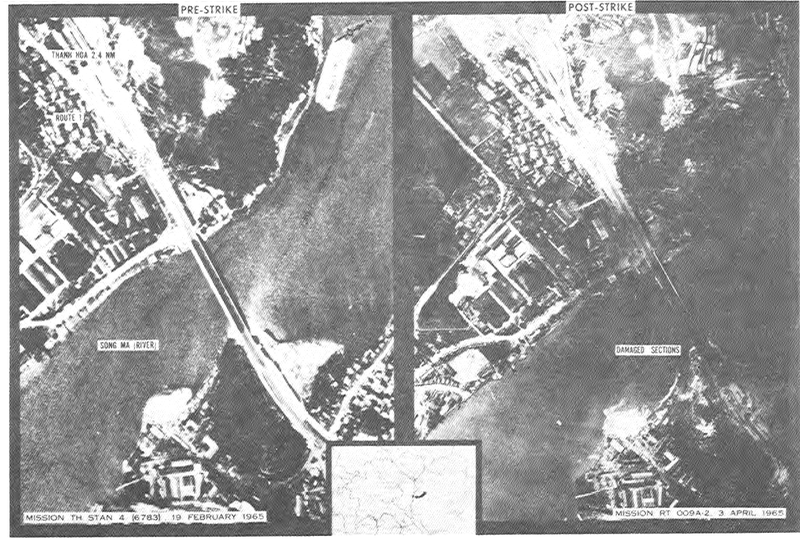
The Thanh Hoa Bridge before and after destruction.
U.S. Air Force/Public DomainThe Thanh Hoa bridge in North Vietnam was a road and rail bridge carrying vast quantities of supplies to the south. A concrete abutment at each end supported the bridge, with a pier in the middle—a layout which reminded some of a gaping mouth, giving it the nickname “Dragon’s Jaw.” Five whole anti-aircraft regiments with over 150 medium and heavy anti-aircraft guns defended the bridge. The U.S. Air Force flew over 800 sorties against the bridge, and succeeded in hitting it with 120 weapons. These were a mix of 250-pound “Bullpup” guided missiles and unguided 750-pound bombs, but they all failed to bring down the supports or close the bridge.
The Air Force needed something more powerful to destroy the robust Dragon’s Jaw bridge, a radical new type of weapon. So in 1965, the service’s Armaments Research Laboratory at Eglin Air Force Base set out to build it. The details of the plan, part of a top-secret mission called Caroline Moon, were revealed in an Air Force monograph published 20 years later.
Kiloton-Power Punch
The bomb was based on a new principle known as mass focus: rather than distributing its blast in all directions, it would concentrate all the force in one direction, focusing it like a lens. This is similar in concept to shaped charges used to penetrate armor, but with the goal of transferring as much blast as possible along a single axis. The mass-focusing effect was achieved by detonation from the circumference traveling to the center.
The weapon built at Eglin was a pancake-shaped bomb eight feet across and two feet thick, weighing around 5,000 pounds; the Air Force built ten of them. Too big for any attack aircraft, the bomb was to be carried by C-130 transports and parachuted into the water upriver. It would float downstream and detonate when it passed under the bridge.
The Carolina Moon weapons required a whole set of new technologies including parachute deployment, river transit, and fusing.
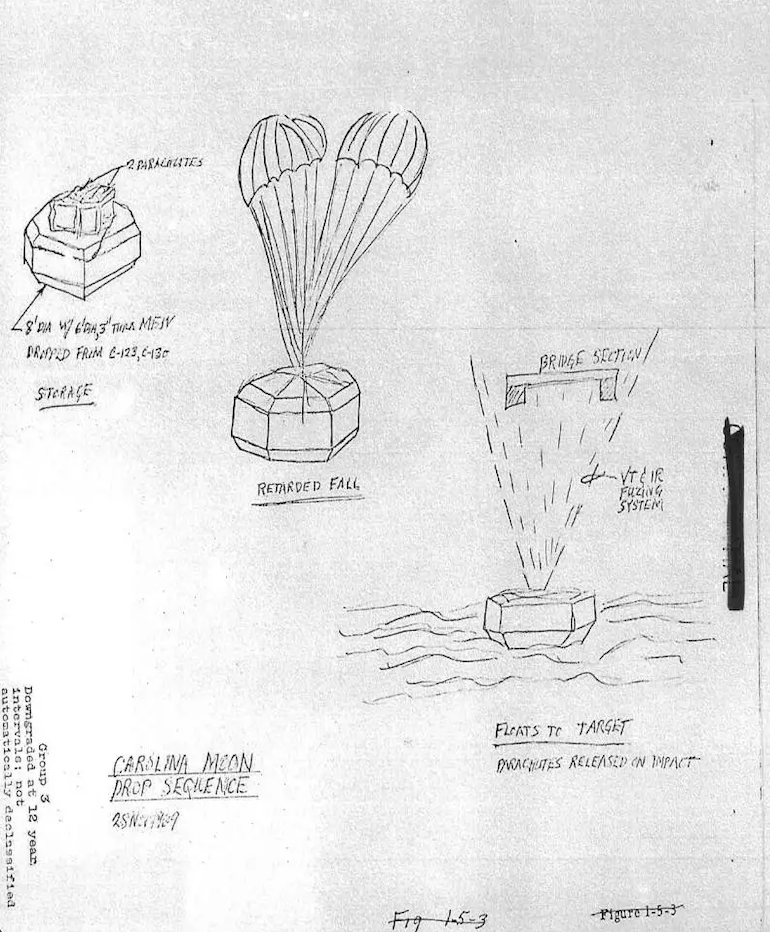
Carolina Moon drop sequence
U.S. Army/Public DomainThe device had two fuses. The first was a radar fuze borrowed from the CIM-10 BOMARC surface-to-air missile with a wide field of view; this would give warning that the weapon was approaching the bridge. The second was an infrared optical fuze with a narrow field of view to trigger the bomb when it was exactly underneath the span.
Air Force tests on concrete targets showed that the mass focus effect was extremely effective. Theoretical calculations indicated that 20 to 30 feet above the bomb, the blast was equivalent to a one-kiloton nuclear warhead detonated under the bridge. That would be more than enough to bring down the road and railway above, which were not built to withstand upward pressure.
Five of the floating bombs were dropped upstream of the bridge. Later reports suggested that four of them went off, but for unknown reasons they had not damaged the bridge. The most likely suggestion is that a fusing failure detonated the bombs either too early or too late, and the focused blast missed its target.
The Carolina Moon plan had to be secret because there was a simple countermeasure: nets upstream would prevent any bombs from reaching the bridge. The U.S. attempted a second attack, but the C-130 was shot down before it could complete its mission, and no further efforts were made with this method.
In 1968, the Air Force deployed another new type of weapon against the bridge: Paveway laser-guided 2,000-pound and 3,000-pound bombs. Eight F-4 Phantoms attacked the bridge in 1972 and dislodged it from one abutment, finally halting traffic.
Since then, 2,000-pound laser-guided bombs able to bring down supports have been the preferred weapon for bridge dropping. This has not been an option for Ukraine, though, as Russia dominates in the air and Ukraine lacks effective strike aircraft able to get through Russian air defenses.
Kamikaze Drone Boats
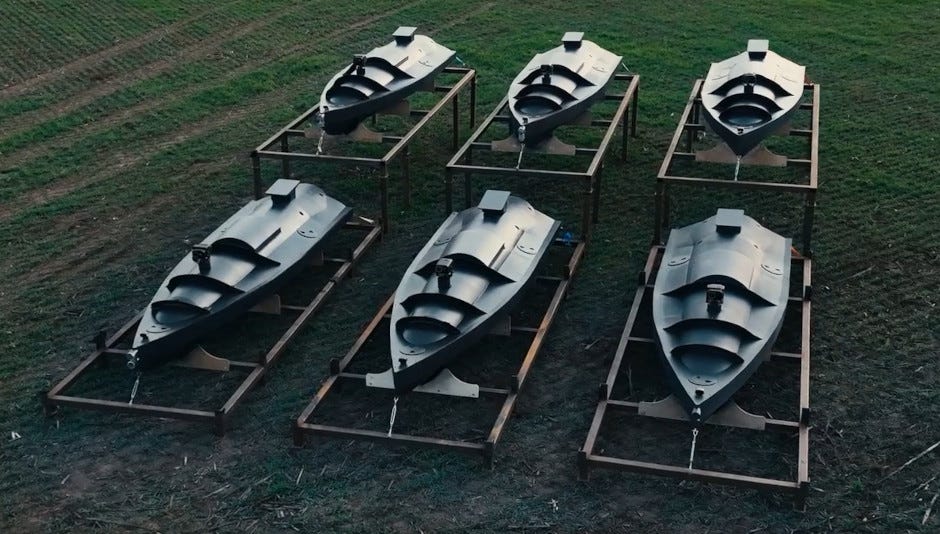
Ukraine’s uncrewed surface vessels.
H I Sutton/ Covert ShoresUncrewed surface vessels, or USVs, represent another way of attacking bridges, which by their nature are accessible by water. While Ukraine has used this type of vessel to target Russian warships several times, it was Russia that sent a USV packed with explosives to hit the Zakota bridge connecting Ukraine with Moldova in the first attack of its type. News reports suggested that one of the concrete bridge supports was damaged, though the bridge was not closed.
This is a sign that targeting the toughest part of the bridge with a relatively small explosive charge is not the best approach.
The damage is very different from the Kerch Bridge, where videos show that the concrete supports appear to be intact, but one stretch of the roadway they support is severely damaged. Rather than hitting the supports, Ukraine may have used a floating bomb with its blast focused upward.
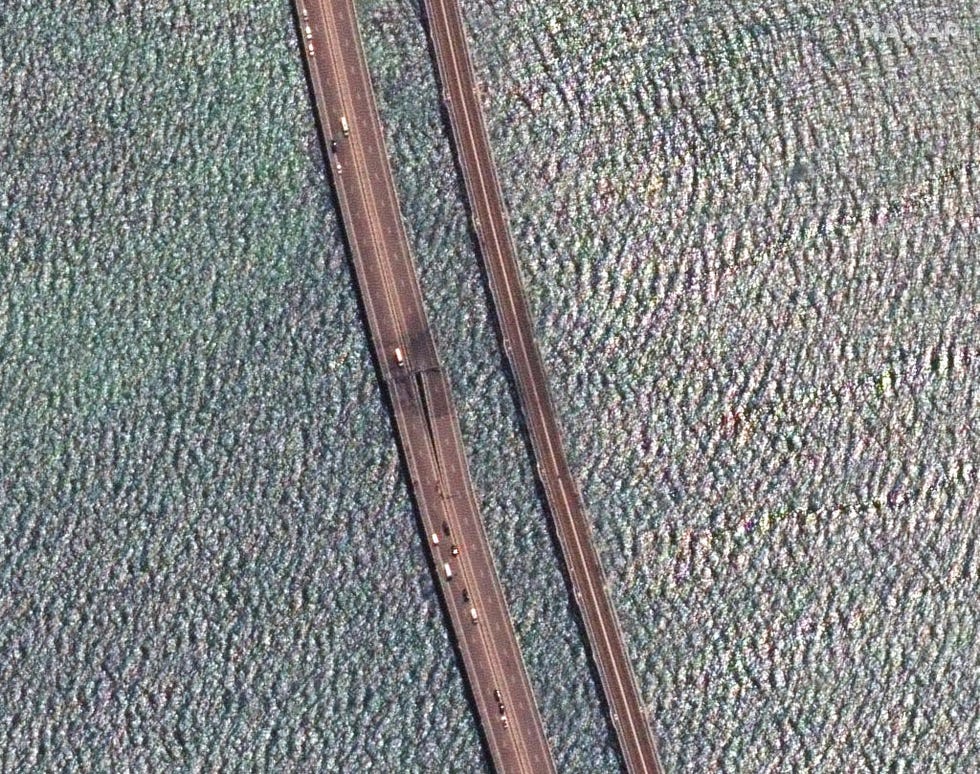
Maxar satellite imagery showing a closeup view of Kerch Strait and the new damage to the Crimea Bridge which connects Crimea to Russia’s mainland, July 17, 2023.
Getty ImagesNew video of the attack released by the Ukrainians does not reveal much new detail. However, the CCTV footage from the bridge does show two of the drone boats, each of which is at least partially underneath the bridge when it detonates, rather than striking a support beam.
The Ukrainian USVs seen so far only carry a charge of about 440 pounds, far smaller than the Carolina Moon weapons, but something bigger may have been used on this occasion. It is also possible that the design is more sophisticated than that of almost 50 years ago, and precise modeling can produce those kiloton-strength effects with something smaller.
Either way, the effects speak for themselves. The roadway is more vulnerable than the bridge supports, and the bridge has been partly closed. Another strike could close it completely, and the success proves this is a viable way of striking bridges.
Ukrainian designers will be looking very closely at the effects of the July 17 strike on the Kerch Bridge and tailoring their next attack accordingly.



Comments
Post a Comment